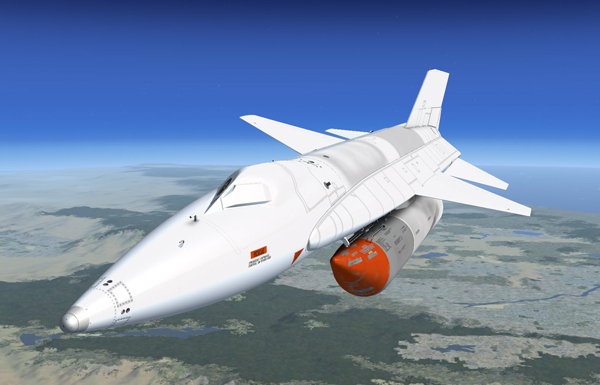
X-15A-2 SE after launch.
It is possible to simulate a high-altitude launch by using the slew mode commands to reposition the X-15 airplane without flying in real time. A second option is to change the altitude and speed settings in the map window, available from the "World" menu item on the simulator's top menu bar.
When the X-15A-2 SE addon is launched from a high altitude, the following control surface deflections are recommended:
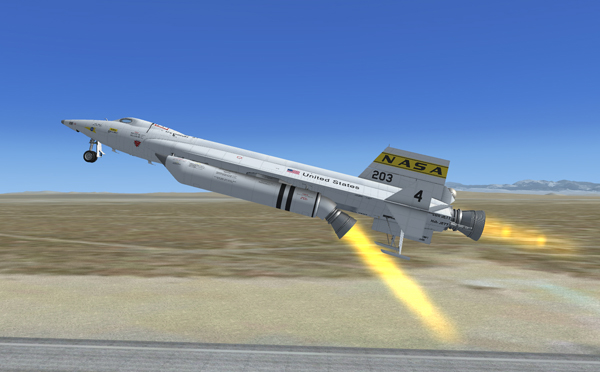
Xtreme Prototypes fictitious X-15AD-4 taking off (Edward AFB).
When taking off from a runway like a conventional aircraft in the simulator, control surfaces must be adjusted to maintain a nose-up climb/pitch angle of about 30 to 45 degrees.
Note: The real X-15 was not designed for a normal takeoff from the ground. Instead, it was dropped from a modified B-52 carrier airplane at an altitude of about 45,000 feet. Because of the position of the rear landing gear relative to the center of gravity, it is normal for the rear skids to sink slightly into the ground when the airplane takes off, especially if you pull back too much on the center stick.
Takeoff (from the ground) can be accomplished with the X-15A-2 SE addon at around 250 to 280 knots IAS by gently pulling on the joystick. The X-15 has a very low lift-drag ratio at low speed (one that produces little aerodynamic lift).
As soon as the aircraft is airborne, raise the landing gear by pushing the landing gear handle [65, fig. 5-1] on the left wing panel (or by pressing the "G" key on your keyboard or the appropriate button on your joystick). When the landing gear is up, the ventral (or the dummy ramjet) [17, 18, fig. 3-2] will appear.
Note: On the real aircraft, the X-15 pilot could not retract the landing gear once it has been deployed because it was locked in place.
Once the rocket engine is ignited, the X-15A-2 SE will accelerate at a very high rate to high Mach numbers and will reach high altitudes in a matter of seconds. Refer to "Aircraft Reference Information" and "Operating Limitations" for airspeed vs altitude limitations. Use the throttle [12, fig. 5-4] and the speed brakes handles [13, 14, fig. 5-4] to increase or decrease velocity depending on mission objectives and altitude.
If strong movements are applied to the joystick and translated to the control surfaces of the airplane traveling at several times the speed of sound, the pilot may lose control of the aircraft. During the initial acceleration (zooming) phase, it is recommended to apply only enough movement to the joystick to maintain the correct nose-up pitch angle and a smooth climb.
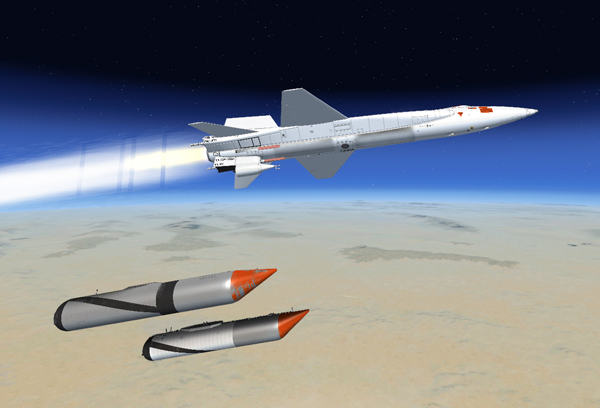
External tanks are released from the X-15A-2 SE.
The X-15A-2 SE is equipped with two large external aluminum propellant tanks [28, 29, fig. 3-1] to provide a longer engine run which results in added velocity. In flight, the liquid oxygen and ammonia from the external tanks are transferred, under helium pressure, to their respective internal tanks. Indication of propellant flow from the external tanks is displayed to the pilot on the external tanks fuel flow indicator [4, fig. 5-1] on the main instrument panel.
When the fuel selector switch [8, fig. 5-6], on the external tanks control panel, is set to EXTERNAL (propellant system pressurized), a transfer system is activated and the propellant is transferred from the external tanks to the internal tanks. At the end of a preset time period, an intervalometer times out, deactivating the transfer system, and the two external tanks jettison-ready indicator lights [4, fig. 5-1] in the cockpit come ON, indicating that the tanks are ready to be released. The propellant feed system automatically shifts to the internal tank feed.
When the external tanks jettison auto-manual switch [3, fig. 5-6] is set to AUTO (fuel selector switch at EXTERNAL and external tanks jettison safe-arm switch [4, fig. 5-6] to ARM), the automatic mode of external tank release system is activated. When the intervalometer times out, the external tanks are automatically released.
Placing the switch to MANUAL activates the manual mode of the external tank release system. To release the tanks, the pilot must press one of the external tanks jettison buttons [5-7, fig. 5-6].
Refer to "X-15A-2 Drop Tank System" for more information.
After the external tanks are released, the X-15A-2 will quickly accelerate to higher Mach numbers until the pilot shuts down the engine or until a normal "burnout" occurs after the propellants are exhausted. The maximum speed to be attained on the current simulation platforms is approximately Mach 4.65.
In a typical X-15 mission, a burnout will occur after more or less 90 to 150 seconds of XLR-99 engine operation (depending if the external tanks are installed or not).
An engine timer (stopwatch) [11, fig. 5-1] is installed on top of the main panel. The timer is automatically started upon ignition and would later tell the pilot when to shut down the engine, depending on mission objectives (altitude and velocity to be attained).
Make sure the engine timer was RESET, if not indicating 0, before the ignition sequence starts.
Once burnout occurs during a high-altitude mission or when the engine is shut down during a high-speed mission, the X-15 will pursue her ballistic trajectory, sometimes reaching even higher altitudes before commencing her descent. The pilot will then set up the correct angle-of-attack for reentry into the earth's atmosphere (high-altitude mission) and perform a 5G to 7G pullout to level flight at about 70,000 feet, after reentry. The speed brake will be applied to further reduce the speed of the aircraft during the descent.
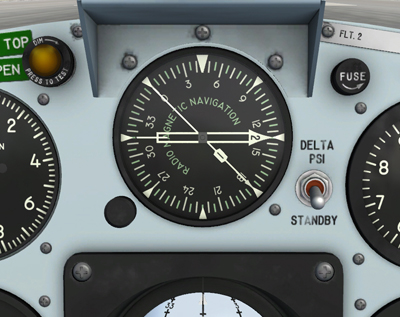
Optional RMI indicator for navigation.
At the time of publication, ballistic control for rocket airplanes was still not supported in either Microsoft® Flight Simulator X or Lockheed Martin® Prepar3D®. Because aerodynamic control surfaces become less and less effective above about 125,000 feet in the simulator as dynamic pressure decreases, we recommend flying the X-15A-2 addon below 200,000 feet. Surprisingly however, the simulator will still give you limited control at high altitudes, but flying will become more challenging.
Note: The highest altitude attained by the real X-15A-2 rocket plane was 249,000 feet (August 3, 1966).
We found that the best way to complete a ballistic trajectory at high altitude is to level off and maintain heading after the engine is cut off. With the nose slightly down, eventually the aircraft will lose altitude until the control surfaces become effective again. For more information about this technique, refer to "The X-15 Experience".
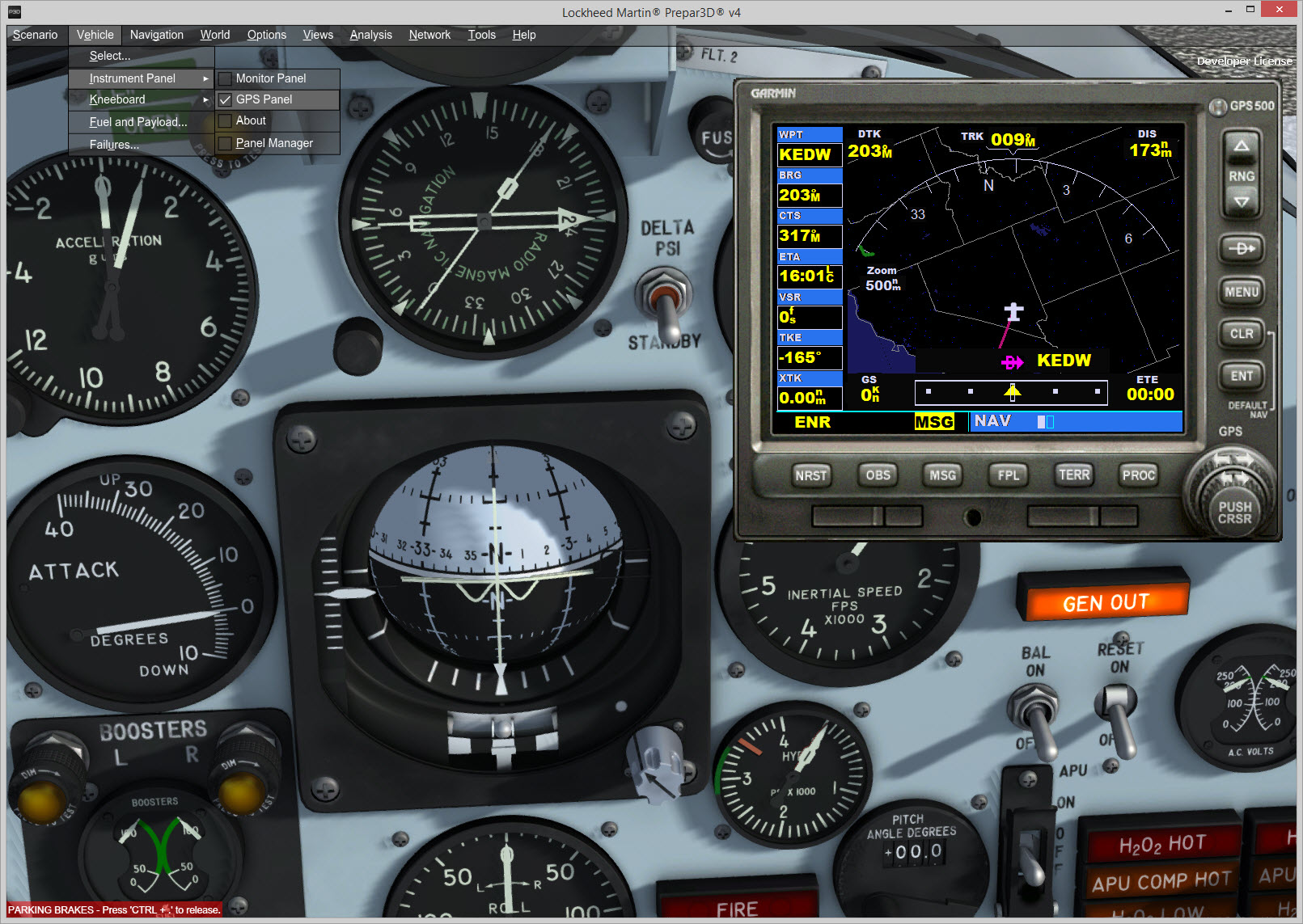
Navigating with the X-15A-2 SE (Prepar3D® v4 screenshot).
You can use the simulator's Garmin 500 GPS, available from "Views/Instruments" (or “Vehicles/Instrument Panel”) in the top menu bar, to track your flight and determine the most appropriate time to shut down the engine before reaching your final destination. You can also use the navigation tools included with the X-15A-2 SE addon:
Note: On a real mission, the pilot receives guidance from ground station and from the chase plane pilots to help him navigate.
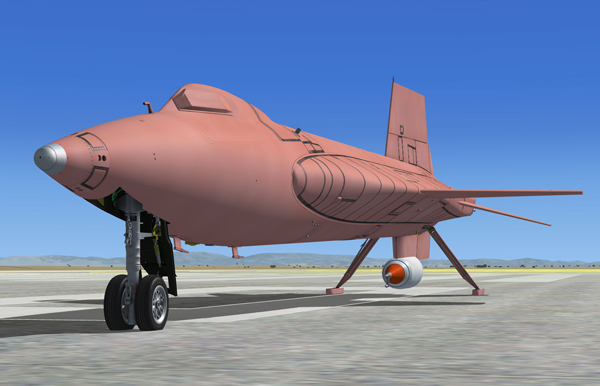
The Martin MA-25S pink ablator was applied before the Dow Corning DC90-090 white protective wear layer.
Hypersonic flight generates tremendous amount of heat and a special ablative coating was used to protect the exterior of the X-15A-2 aircraft on special missions. It consisted of the basic Martin MA-25S pink ablator (still being used today on the space shuttle external tank) sealed with the Dow Corning DC90-090 white protective wear layer.
A protective “eyelid” was designed to protect the left canopy window from being smeared with ablator residue during high-speed flight. The eyelid is closed before the acceleration phase and re-opened before landing. A special handle [6, fig. 4-3], in the cockpit, is used to open or close the eyelid.
Note: If you forgot to close the eyelid before a high speed flight, you can right-click the eyelid handle to clean ablator splatters from the windows.
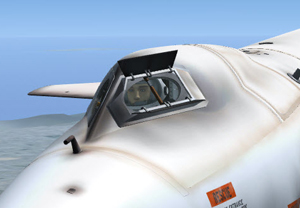
Protective eyelid on the left window.
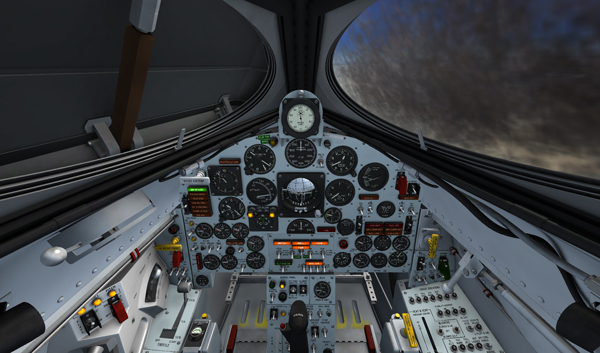
Ablator splatters on the right (unprotected) window.
See also:
Radio-Communication and ADF/VOR Systems